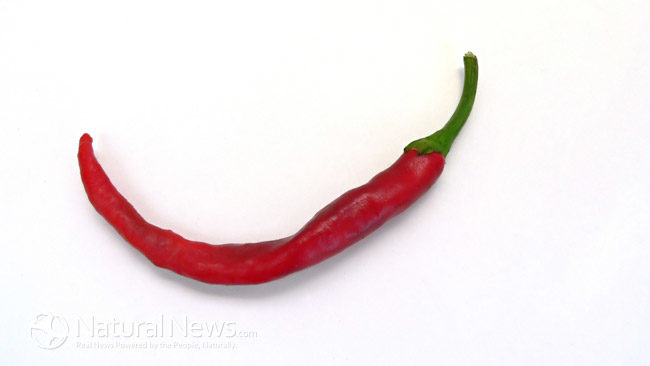Cayenne is one of the most important herbs in the world. Native Americans have used cayenne in food and medicine for at least 9,000 years.
The botanical name for cayenne is capsicum minimum. In Greek, the name means, “to bite.” Other common names for this herb are, Guinea Pepper, Spanish Pepper, Bird Pepper, and African Pepper, to name a few. It comes from the Solonaceae, or nightshades, family of flowering plants.
The spicy, hot taste of cayenne pepper is primarily due to a substance known as capsaicin. The health benefits of this pungent herb is often ridiculed and ignored. But capsaicin and cayenne have quite a few health uses worth noticing.
Capsaicin and cayenne
Capsaicin is the most active ingredient in cayenne. Other significant ingredients in this herb include vitamins A and C, carotenoids, and flavonoids.
Traditional uses of cayenne include the following:
- It’s scattered around the home to break bad spells.
- It can inflame a loved one to passion.
- It’s added to love powders to ensure love will be spicy.
Medicinal uses of this red pepper are quite astounding. The Chinese, Indian Ayurvedic, Koreans, and Japanese, have used it as a traditional medicine, as well as an oral remedy for circulatory problems, suppressing appetites, and stomach problems.
It has also been applied to the skin for muscle pain and arthritis. When capsaicin is applied to the skin, it provides some powerful pain-relieving properties.
Today, capsaicin is used in Europe and the United States in ointments and creams to relieve pain and discomfort from shingles and arthritis.
According to the University of Maryland Medical Center, capsaicin found in cayenne, “…reduces the amount of substance P, a chemical that carries pain messages to the brain, in your body. When there is less substance P, the pain messages no longer reach the brain, and you feel relief.”
Internal uses
Cayenne helps to stimulate the action of other herbs. It provides natural warmth and has been used for treating ailments, including sore throat, heartburn, nausea, gout, hemorrhoids, and fever.
The following are a few internal uses of cayenne and often-recommended uses of capsaicin:
- Immune system conditions — Cayenne helps to build up a resistance at the beginning of a cold. It also helps prevent disease in people exposed to cold and damp for any length of time. Preliminary studies suggest capsaicin has anti-tumor properties and may play a role in treating certain cancers including prostate, gastrointestinal, and colon cancer.
- Gastrointestinal conditions — It helps to relieve stomach and bowel cramping and pain. In addition, it stimulates digestion.
- Female conditions — Helps to relieve menstrual cramps.
- Weight loss — A few studies suggest capsaicin helps in suppressing appetites and makes people feel full. Researchers in one study reported they found that, “Capsaicin and green tea suppressed hunger and increased satiety…”
External uses
Cayenne used in liniments and plasters, or tincture, helps to increase blood flow to areas of the body. When directly applied, the healing properties of cayenne help in the following ways.
- Pain relief — Several studies suggest capsaicin cream can reduce lower back pain.
- Rheumatoid arthritis and osteoarthritis — It’s also recommended for rheumatoid arthritis and osteoarthritis — in addition to muscle or joint pain from fibromyalgia or other causes.
- Diabetic nerve pain — The American Academy of Neurology notes moderate evidence that capsaicin helps to relieve pain from nerve damage in the feet or legs from diabetes, called diabetic peripheral neuropathy.
- Psoriasis — Capsaicin cream can reduce inflammation and itching from psoriasis. Psoriasis is a skin disease that usually appears as patches of raised, red skin covered by a flaky white buildup.
Herbal use and forms
For herbal use, the cayenne peppers are usually ground into a powder. Then they are mixed with other powdered herbs in capsules or made into a tincture.
When consuming cayenne as a spice, it may be eaten raw or cooked. Dried cayenne pepper comes in a powdered form. It can be added to food, or you can stir it into milk, tea, or juice. It’s available in capsule form, as well. For external use, it’s available in creams. Creams should contain at least 0.075 percent capsaicin, in order to be effective.
Precautions
For centuries, civilizations around the world have been using herbs to treat diseases and strengthen the body. But it’s important to note that herbs can also trigger side effects — especially if they interact with other medication, supplements, or herbs.
Consult a health care provider for guidance and supervision.
The University of Maryland Medical Center provides some cautionary advice.
“DO NOT give cayenne to children under 2. However, with caution, capsaicin ointment may be used on the skin for older children. DO NOT use topical cayenne ointments for more than 2 days in a row for a child. If you are using cayenne around children, make sure they wash their hands thoroughly after handling cayenne and DO NOT touch their eyes or nose.”
Additional precautionary advice provided by the university.
“DO NOT use capsaicin with a heating pad, and DO NOT apply capsaicin cream immediately before or after a hot shower. After using capsaicin, wash your hands well and avoid touching your eyes. DO NOT apply capsaicin cream to cracked skin or open wounds.”
Experts generally consider capsaicin safe. But it can cause some unpleasant side effects, especially if you’re not used to it. Be careful when you cook with or eat cayenne pepper — or any hot pepper, for that matter. It’s best to start with small amounts, and increase the amount as you get more used to it.












